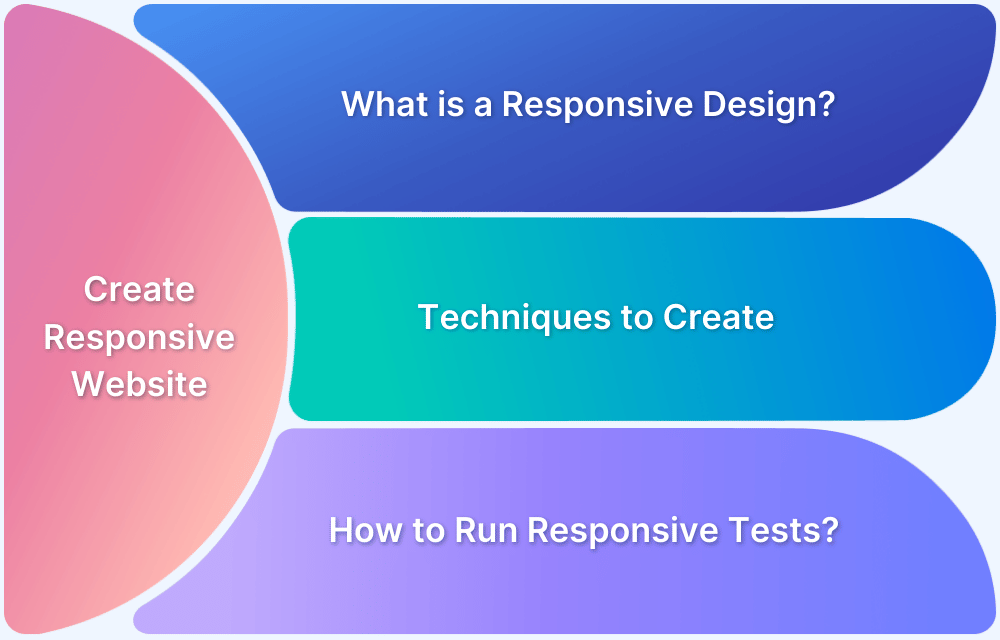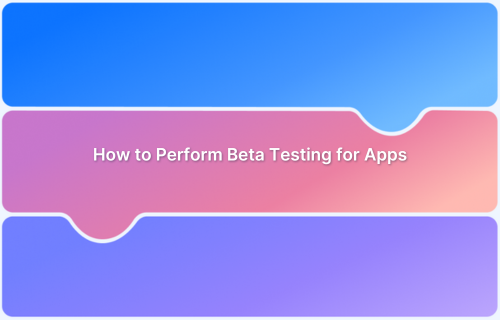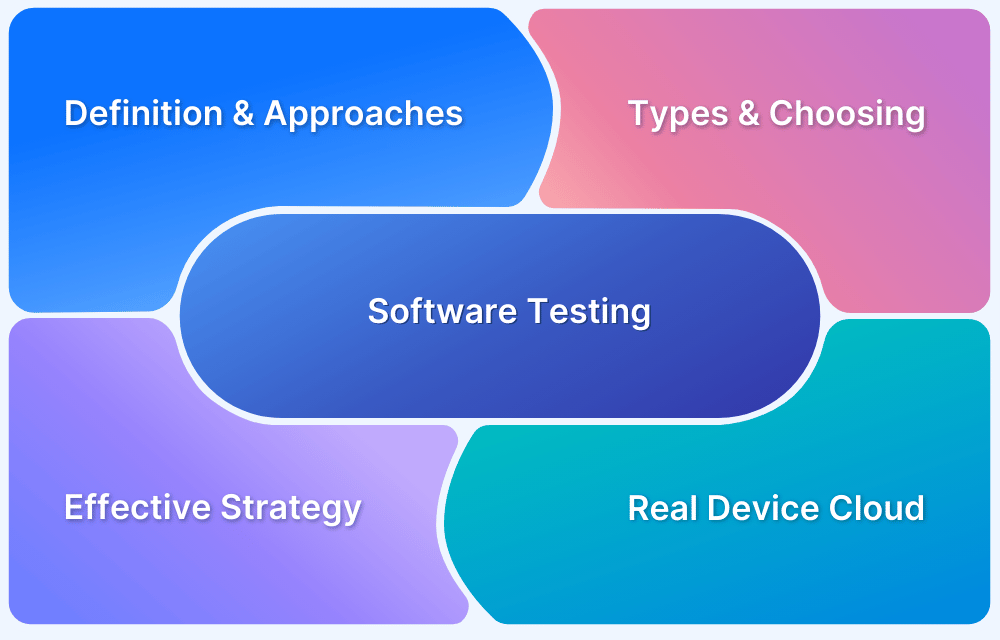A/B testing is an effective technique for optimizing user experience and improving the performance of web and mobile applications. As a developer or tester, mastering A/B testing can help you deliver apps that meet your users’ needs and drive business results.
Overview
What is A/B Testing?
A/B testing (split testing or bucket testing) compares two or more variations of a digital asset (like a webpage, app, or email) to determine which achieves better outcomes, such as higher conversions, engagement, or click-through rates.
How A/B Testing Works:
- Users are randomly divided into groups.
- Each group interacts with a different page version – the original (version A) and modified (version B).
- User interactions with each version are tracked and recorded.
- The performance metrics of each version are analyzed and compared.
- The page version with the best performance is implemented as the live version.
Common Use Cases of A/B Testing
- Website Design: Test different layouts, button colors, or CTAs.
- Email Campaigns: Experiment with subject lines, content, or images.
- Product Features: Compare two versions of a feature or workflow.
- Ads: Test headlines, visuals, or copy.
Benefits of A/B Testing
- Data-driven decision-making.
- Minimized risk of implementing ineffective changes.
- Continuous improvement of user experience and business metrics.
Challenges of A/B Testing
- Requires sufficient sample size for statistically significant results.
- Potential biases if user segmentation isn’t random.
This ultimate guide will take you through everything you need to know to become an A/B testing pro.
What is A/B Testing?
A/B testing (bucket, split, or variant testing) is an experimentation method where two or more versions of a digital asset, such as a webpage, app interface, or email, are tested with different user groups to identify which version delivers better results.
Developers use A/B testing to test and optimize various features, such as page layouts, color schemes, user interfaces, or workflows. Testers use A/B testing to ensure that the application or website functions correctly and identify potential issues or bugs.
A/B testing involves specialized tools and libraries that help implement and manage the testing process to interpret and analyze the results.
Why should you consider A/B testing?
A/B testing is essential for optimizing digital experiences and improving customer engagement. Here’s why you should consider it:
- Data-Driven Decisions: Removes guesswork by providing clear, measurable results on what works best for your audience.
- Improved User Experience: Identifies changes that resonate with users, making your website, app, or content more engaging and effective.
- Higher Conversions: Helps refine elements like CTAs, layouts, or headlines to maximize user actions such as purchases or sign-ups.
- Reduced Risk: Tests changes on a small scale before full implementation, minimizing the risk of ineffective updates.
- Continuous Optimization: Enables iterative improvements, keeping your digital assets aligned with user preferences and industry trends.
- Better ROI: Enhances the performance of marketing campaigns and digital products, leading to a higher return on investment.
What Elements can you A/B test?
You can A/B test various aspects of a software application or website, depending on the goals and objectives of the test. Some elements that can be A/B tested include:
- User interfaces: It compares different user interface designs to determine which design is more effective in engaging users and driving conversions.
- Landing pages: You can use A/B testing to test different landing page designs, headlines, images, and calls-to-actions to identify the best-performing combination.
- Navigation and menus: A/B testing can compare different navigation and menu options to determine which design is more effective in guiding users to the desired action.
- Forms and sign-up flows: If you want to test different form layouts, field labels, and sign-up flows to optimize the user experience and increase conversions, you can use A/B testing.
- Pricing strategies: Testers can use A/B testing for testing different pricing models, like subscription plans, discounts, and free trials, to identify the most effective pricing strategy.
Types of A/B Tests
Here are some types of A/B tests you can commonly use:
- Simple A/B Test: This is the most basic type of A/B test, also known as a “two-variation test.” It involves splitting your audience into two random groups and showing each group a different variation of your website, email, or other content. You then measure which variation performs better based on predefined metrics such as click-through, conversion, or engagement rates. The goal is to determine which variation generates the best results and use that version moving forward.
- Multivariate A/B Test: A multivariate test involves testing multiple variations of multiple elements on a website or email. Rather than just two variations of one element, you can test multiple variations of elements on the same page, such as different headlines, images, or call-to-actions. Multivariate A/B testing allows you to see which combination of elements performs best, rather than just one element at a time.
- Split URL Test: In a split URL test, you create two different versions of a webpage with distinct URLs and then randomly direct visitors to one of the two URLs. The goal is to determine which version of the webpage performs better regarding conversions or other KPIs. Split URL tests are useful for testing major redesigns, as they allow you to test significant changes to your website without affecting the rest of the site.
- Redirect Test: Redirect A/B test involves redirecting a portion of your traffic to a different page, which can be on the same domain or a different one. The goal is to determine which page generates better results. Redirect tests are often used to test major changes or to compare completely different pages, such as testing a landing page against the homepage.
- Server-side A/B Test: Server-side A/B test allows you to test changes that cannot be made on the client side, such as changes to the back-end or APIs. Server-side A/B testing can be more complex to set up, but it provides more control over the testing environment and can be more accurate.
A/B Testing vs Multivariate vs Split Testing
Here’s a quick comparison of A/B Testing, Multivariate Testing, and Split Testing to help understand their key differences and use cases:
| Parameter | A/B Testing | Multivariate Testing | Split Testing |
|---|---|---|---|
| Definition | Compares two versions (A and B) of a single variable | Tests multiple combinations of multiple variables | Splits traffic between completely different URLs |
| Complexity | Simple and quick to implement | More complex due to multiple variable combinations | Moderate; requires separate versions of web pages |
| Purpose | To find the better-performing version of a single change | To understand the impact of changes in multiple elements | To compare radically different designs or flows |
| Traffic Requirement | Moderate | High, to ensure statistical significance across all combinations | Moderate to high, depending on the number of pages |
| Best Use Case | Testing one headline, button, or image | Testing multiple headlines, images, and CTAs at once | Testing different layouts or complete page redesigns |
| Result Analysis | Straightforward | Complex, requires advanced analytics | Straightforward |
| Speed of Results | Fast | Slower due to more combinations | Moderate |
A/B Testing Statistical Approach
Selecting the right statistical approach is crucial for conducting effective A/B tests and drawing meaningful business insights.
Two primary approaches are commonly used in A/B testing:
Frequentist Approach
This traditional method sets a null hypothesis (no difference between variants) and an alternative hypothesis (a difference exists).
- The approach calculates a p-value by performing statistical tests, which represents the probability of observing the results if the null hypothesis is true.
- A p-value smaller than a significance level (commonly 0.05) leads to rejecting the null hypothesis in favor of the alternative.
The frequentist method is simpler to implement and widely used in A/B testing scenarios.
Read More: What is Alpha Testing?
Bayesian Approach
The Bayesian method incorporates prior knowledge and updates it using collected data to form a posterior probability distribution.
- It estimates the probability of one variant outperforming another, making it ideal for interpreting results with smaller sample sizes.
- Unlike the frequentist approach, it provides a range of outcomes, offering more flexibility in decision-making.
However, Bayesian testing requires greater expertise and computational resources.
The frequentist approach suits most cases, while the Bayesian method excels with small datasets or nuanced probabilities, ensuring reliable results.
Key factors to consider in Statistical A/B Testing Approach
Here are some important factors that you need to consider for statistical A/B testing:
- Define a clear, measurable hypothesis to guide what you’re testing and why.
- Use a sample size calculator to determine the number of users needed for reliable results.
- Set a significance level (typically p < 0.05) to determine if results are statistically valid.
- Consider effect size to assess the real-world impact of the observed differences.
- Analyze confidence intervals to understand the precision and reliability of the effect.
- Run the test for a sufficient duration to reach statistical power and avoid skewed outcomes.
- Avoid peeking at results mid-test to prevent premature or biased conclusions.
- Randomize and balance traffic allocation to control external variables and ensure fair testing.
- Maintain consistency across test conditions to minimize noise and confounding factors.
- Use validated statistical tools or platforms to calculate and interpret test outcomes correctly.
How to Perform an A/B Test?
Follow these four simple steps to conduct a successful A/B test:
1. Define the Problem: Identify the objective. Is it to increase conversions, clicks, or another key metric? A clear goal ensures a focused test.
2. Set Up Test Groups: Create two groups.
- Control Group: Uses the existing version.
- Treatment Group: Uses the updated version
Ensure both groups are similar in behavior and demographics.
3. Apply Changes: Implement planned changes in the treatment group, such as modifying design, copy, or features. Keep the control group unchanged.
4. Collect and Analyze Data: Run the test for an appropriate duration and analyze the results to check for statistically significant differences:
- Significant Results: Apply the winning version.
- No Significance: Refine the changes and retest.
Following these steps and planning with an A/B testing calendar can drive data-backed optimizations for your app or webpage.
A/B Testing Calendar
Creating an A/B testing calendar is a useful way to plan and organize A/B tests to ensure that they are conducted efficiently and effectively. Here are the four key steps in an A/B testing calendar:
1. Planning the test: The first step in creating an A/B testing calendar is to plan the test. It involves identifying the problem that needs to be solved, defining the goals and objectives of the test, identifying the metrics that will be used to measure success, and selecting the web page or app element. The planning stage also includes defining the treatment and control groups and deciding how traffic will be split between the two groups.
2. Running the test: This stage involves setting up the A/B testing platform, implementing the changes in the treatment group, and monitoring the test to ensure everything is working correctly. It is important to ensure that the test runs for a sufficient length of time to gather a significant amount of data but not too long before it affects other business operations.
3. Analyzing the results: You have to collect and organize the data collected during the test, determine the statistical significance of the results, and assess the changes’ impact on the measured metrics. It is important to analyze the results thoroughly and accurately to ensure that the right conclusions are drawn.
4. Making data-driven decisions: It involves deciding whether the changes should be implemented permanently or whether further tests are required.
You must consider the results in the context of the overall business objectives and assess whether the changes will positively impact the business in the long term.
Popular A/B Testing Tools
Here are some of the most widely used A/B testing tools, each offering unique features to optimize user experiences and drive better business decisions.
Popular A/B Testing Tools
- Optimizely
- Google Optimize
- VWO (Visual Website Optimizer)
- Adobe Target
- Kameleoon
- AB Tasty
- Crazy Egg
- Convert
Below is a description of each of these A/B testing tools.
- Optimizely: A comprehensive experimentation platform that supports A/B, multivariate, and server-side testing. Known for its easy integration and advanced personalization capabilities.
- Google Optimize: A free and straightforward tool for A/B testing. It seamlessly integrates with Google Analytics, offering data-driven insights for websites of all sizes.
- VWO (Visual Website Optimizer): Simplifies A/B and split testing for webpages. It offers features like heatmaps, session recordings, and segmentation, making it ideal for conversion rate optimization.
- Adobe Target: Part of the Adobe Marketing Cloud, this tool provides robust testing and personalization for websites and mobile apps. It is highly suited to enterprises with complex digital ecosystems.
- Kameleoon: Known for its real-time predictive targeting, it enables advanced A/B and multivariate testing. It is perfect for businesses prioritizing AI-driven insights.
- AB Tasty: Combines A/B testing with personalization. It offers intuitive visual editors and detailed reporting, catering to both marketers and developers.
- Crazy Egg: Offers A/B testing complemented by heatmaps and user behavior analytics. It is ideal for uncovering user experience issues and optimizing key site elements.
- Convert: A privacy-focused tool designed for GDPR compliance. It supports A/B, multivariate, and split URL testing and integrates well with various analytics platforms.
Each of these tools caters to different business needs, so selecting one depends on your goals, technical resources, and budget.
Learn More: Top 20 Performance Testing Tools in 2025
A/B Testing Examples
Here are some examples of A/B testing:
Example 1: Testing a Call-to-Action Button
One common use of A/B testing is to optimize the design and copy of a call-to-action button. For example, you can test two different versions of a CTA button on your website, one with the text “Buy Now” and another with the text “Add to Cart”.
By randomly showing each version to a sample of users, the website can determine which version leads to more conversions.
Example 2: Testing a Landing Page Design
Another common use of A/B testing is to optimize the design and content of a landing page. For example, you can test two different versions of a landing page, one with a large hero image and minimal text, and another with a smaller image and more detailed copy. Then you can analyze user behavior metrics like bounce rate, time on page, and conversion rate to determine which version of the landing page is more effective.
Example 3: Testing the Checkout Process
A/B testing can also be used to optimize the checkout process of an e-commerce website. For example, you can test two different versions of the checkout process, one with a multi-step form and another with a single-page one.
Analyze the results for both scenarios using metrics like cart abandonment and conversion rates to determine which version of the checkout process is better at driving sales.
These examples can help you get a brief idea of how to use A/B testing for your websites and applications.
Metrics to consider for A/B Testing
By monitoring the following key metrics, you can gain a comprehensive understanding of user behavior, identify winning variations, and ensure your A/B testing drives meaningful improvements.
| Metric | Description |
|---|---|
| Conversion Rate | Percentage of users completing the desired action (example: purchase, sign-up). It is the primary success metric. |
| Statistical Significance | Validates that the results are reliable and not due to random chance. |
| Click-Through Rate (CTR) | Ratio of users clicking a specific link or CTA. It measures user engagement. |
| Revenue Per Visitor (RPV) | Average revenue generated per user for each variation. It provides a financial performance perspective. |
| Bounce Rate | Percentage of users leaving a page without taking action. It indicates engagement quality. |
| Time on Page | Average time users spend on a page; reflects content relevance and user interest. |
| Engagement Metrics | Includes actions like scrolling, element interactions, and pages viewed; captures deeper user behavior. |
| Cost Per Conversion (CPC) | Cost to acquire a single conversion; helps evaluate efficiency. |
| Retention Rate | Percentage of users returning after their first visit. It indicates long-term effectiveness. |
How to Interpret A/B Test Results
Interpreting A/B test results involves analyzing data to determine which variation performed better and why. Follow these steps:
- Check Statistical Significance: Ensure the results are statistically significant using a predefined confidence level (commonly 95%). This confirms that observed differences are unlikely due to chance.
- Compare Conversion Rates: Examine the primary metric (for example, conversion rate) to identify which variation achieved better results. Focus on the percentage improvement over the control.
- Analyze Secondary Metrics: Look at supporting metrics such as click-through rate, bounce rate, or time on page to gain deeper insights into user behavior and engagement.
- Consider Practical Significance: Even if differences are statistically significant, assess whether the improvement is meaningful for your business goals. A small change may not justify implementation costs.
- Evaluate Sample Size: Verify that the test reached the required sample size to ensure reliable and representative results. Small samples can lead to misleading conclusions.
- Account for Variability: Consider factors like seasonal trends, user segments, or device types that may have influenced the results. Segment analysis can provide additional context.
- Check Consistency Over Time: Observe whether the winning variation maintains its performance when tested over different time frames to avoid short-term bias.
- Review Confidence Intervals: Confidence intervals help estimate the range within which the true performance of each variation lies, providing a better understanding of variability.
- Understand Causation vs. Correlation: Ensure the changes directly caused the observed results, avoiding misinterpretation of coincidental trends.
- Document Learnings: Record the outcomes, insights, and any anomalies from the test. Use these learnings to inform future experiments.
The impact of A/B testing on SEO
A/B testing can impact SEO in several ways. For example, testing changes to website content, structure, or design can impact how search engines crawl and index the website. If not done properly, A/B testing can lead to duplicate content issues, broken links, or other technical problems that can negatively impact SEO.
Also, A/B testing can impact user behavior on the website, such as engagement, conversion, or bounce rates. These user behavior metrics can indirectly impact SEO, as search engines often consider user behavior when ranking websites in search results.
There are multiple best practices you can use to ensure that A/B testing doesn’t harm your SEO score and help you maximize the organic
A/B Testing Mistakes to Avoid
Although you can use A/B testing as a powerful tool for optimizing web pages and apps, it is important to avoid common mistakes to ensure that the results are accurate. Here are five common A/B testing mistakes to avoid:
1. Not having a clear hypothesis: You must have a clear hypothesis to face the difficulty of knowing what changes to make and what metrics to track. Focus on defining the problem that needs to be solved and identifying the metrics used to measure success.
2. Not having a large enough sample size: To obtain desired results from an A/B test, it is important to have a large enough sample size. If the sample size is small, the results may be skewed or not statistically significant. A larger sample size will also help ensure that the test is representative of the overall population.
3. Not running the test for a long enough time: Running an A/B test for a sufficient length is critical for obtaining reliable results. If the test is not run long enough, there may not be enough data to conclude, or other factors may affect the results. It is important to determine the appropriate length of time to run the test based on the data and the goals of the test.
4. Not controlling for confounding variables: While performing A/B testing, you must control for confounding variables that may affect the results. Confounding variables are factors that may affect the outcome of the test but are not related to the changes being tested. These variables could include the time of day, traffic source, or user demographics. Controlling these variables helps to ensure that the results are precise.
5. Not considering multiple metrics: The last mistake you should avoid is not considering multiple metrics to understand the impact of the tested changes. Focusing only on one metric may not provide a complete picture of the results.
Best Practices for A/B testing
Some best practices for A/B testing include:
- Prioritize SEO considerations when designing A/B tests. This includes avoiding duplicate content, ensuring proper use of headings and tags, and testing changes on a small scale before implementing them site-wide.
- Work with SEO experts to ensure that A/B testing is conducted in a way that is consistent with SEO best practices.
- Monitor website performance metrics, such as traffic, bounce rate, and conversion rate, before and after A/B testing to determine the impact of the test on user behavior.
- Avoid testing too many variables at once, as this can make it difficult to determine which changes impact user behavior.
Why conduct A/B testing on Real Devices?
Conducting A/B testing on real devices is essential for achieving accurate and actionable results. Real devices reflect real user conditions, accounting for factors like processing power, screen resolution, and network conditions, which simulators often miss.
A/B testing on actual devices helps uncover platform-specific behaviors, as different operating systems and browsers may handle design elements differently.
Testing on real devices also ensures authentic user interactions, capturing gestures like taps and scrolling that may differ in simulated environments. Additionally, real world network variability, such as slow connections or offline modes, is better accounted for during A/B testing on physical devices.
This approach also helps identify hardware-specific bugs and ensures that accessibility features are functional for all users. By incorporating real devices into your A/B testing process, you ensure more reliable insights that lead to better optimizations and improved user experiences.
Conclusion
A/B testing optimizes user experiences and improves conversions and engagement. To ensure reliable and actionable results, testing on real devices is critical, as it captures real-world conditions that simulations often miss.
Opt for testing platforms like BrowserStack to enhance the accuracy of your A/B testing. With access to 3,500+ real devices, operating systems, and browsers, you can replicate real-user conditions, uncover platform-specific behaviors, and ensure seamless experiences across diverse environments.







